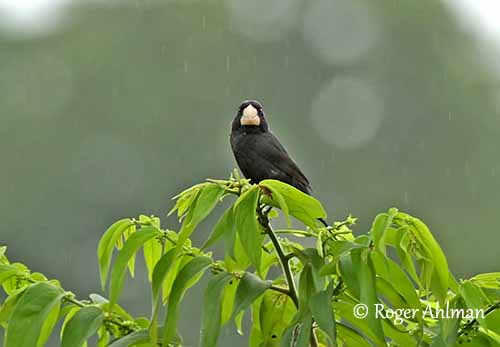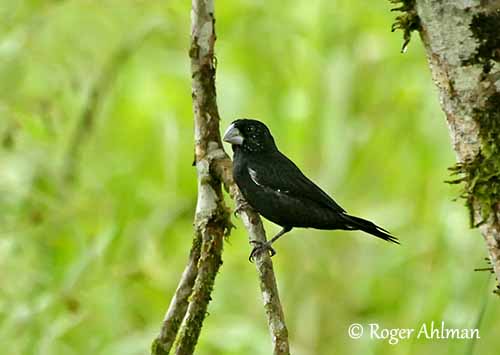
Fr: Sporophile crassirostre
Ang: Large-billed Seed-Finch
All: Mohrenreisknacker
Esp: Semillero Piquigrande
Ita: Beccasemi beccolargo
Nd: Dikbekzaadkraker
Sd: ljusnäbbad fröfink
Photographer:
Roger Ahlman
Pbase Galleries Peru and Ecuador
Text and picture of the sedge by Nicole Bouglouan
Sources:
HANDBOOK OF THE BIRDS OF THE WORLD Vol 16 by Josep del Hoyo- Andrew Elliot-David Christie – Lynx Edicions – ISBN: 9788496553781
A GUIDE TO THE BIRDS OF COLOMBIA by Steven L. Hilty and William L. Brown - Princeton University Press – ISBN 069108372X
BIRDS OF SOUTH AMERICA – Passerines - by Robert S. Ridgely and Guy Tudor – HELM Field Guides – ISBN: 9781408113424
BIRDS OF VENEZUELA by Steven L. Hilty – Ed. Christopher Helm – ISBN: 0713664185
Neotropical Birds – Cornell Lab of Ornithology
BEHAVIOR OF THE GRASSLAND SPARROW AND TWO SPECIES OF SEED-FINCHES by ALAN LILL
Home page
Page Passeriformes Order
Large-billed Seed-Finch
Oryzoborus crassirostris
Passeriformes Order – Thraupidae Family
INTRODUCTION:
The Large-billed Seed-Finch is a member of genus Oryzoborus which gathers small to medium-sized finches. Males are almost entirely black and the females mostly buff to brown. But the more interesting feature is the massive, deep bill with nearly straight culmen, well-adapted to the diet of these species.
The Large-billed Seed-Finch favours the seeds of large sedges of family Cyperaceae, found in its foraging areas often near water.
This bird is reminiscent of the Darwin’s Finches, with a well-adapted morphology to both diet and feeding behaviour.

DESCRIPTION OF THE BIRD:
Biometrics:
Length: 14-14,5 cm
Weight race “crassirostris”: 20-22 g
Weight race “occidentalis”: 22-28 g
The adult male of nominate race “crassirostris” has black plumage overall, except the white wing patch at base of primaries. The underwing-coverts and the bend of the wing are white and conspicuous in flight. The black tail is rather long.
The adult male of race “occidentalis” (displayed on this page) is similar, but it has smaller white wing patch and darker underwing.
The huge bill is chalky white to ivory white and glossy. It is so massive that the crown appears to sweep back from the base of the upper mandible. The bird looks flat-headed.
The eyes are blackish-brown. Legs and feet are black.
The female has brown upperparts with slightly darker wings and tail. The underparts are paler, mostly buffy-brown, with white underwing-coverts, but she lacks the white wing patch of the primaries.
She has blackish bill. The eyes are very dark. Legs and feet are blackish.
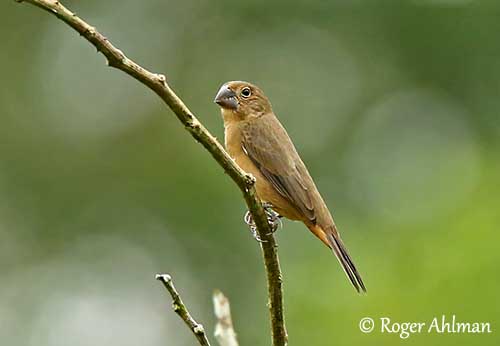
The juvenile resembles female, but the young male shows slightly streaked head and the wings are darker. The bill is horn-coloured and the throat appears paler.
SUBSPECIES AND RANGE:
The Large-billed Seed-Finch has two recognized subspecies.
O.c. occidentalis is found on the Pacific slope of Colombia, S to SW Ecuador.
O.c. crassirostris is found in Venezuela, the Guianas and E Colombia, S to NE Peru, and N and W Brazil. This species was formerly on Trinidad, but it appears to have been extirpated.
HABITAT:
The Large-billed Seed-Finch frequents freshwater marshes, riparian thickets and second growth scrub. It can be seen in tall emergent vegetation along rivers and by swamps and lakes. It occurs in grassy borders of dry forest and in seasonally flooded areas with bushes, trees and grass, and generally in semi-open habitats.
This species is visible from sea-level to 500 metres of elevation, usually below 700 metres.
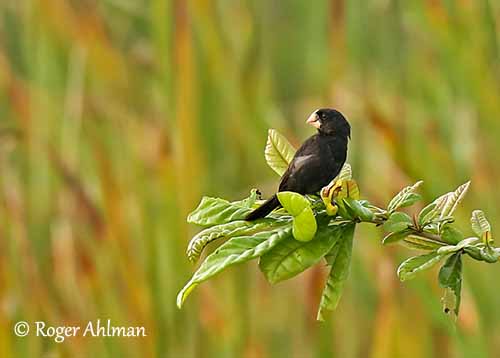
CALLS AND SONGS: SOUNDS BY XENO-CANTO
The Large-billed Seed-Finch of race “occidentalis” gives a rich warbling that may include mimicry.
The song of the race “crassirostris” is a rich, mellow, whistled “twee teer, d’d’d’d’ twee-teer, twee-teer, du-weet, du-weet” and some variants. Usually, the song starts slowly and then, speeds up.
The Large-billed Seed-Finch also has a flight song often more complex and longer than the usual perched song.
The call is an explosive, sharp “chwit” or “tchweet”.
BEHAVIOUR IN THE WILD:
The Large-billed Seed-Finch is generally less gregarious than other seedeaters, and is often seen alone or in pairs, and occasionally in small flocks.
It feeds mainly on seeds of large sedges of family Cyperaceae, and may take some insects. It perches on stems or another close perch, in order to reach the seedheads, but it may sometimes feed on the ground by hopping.
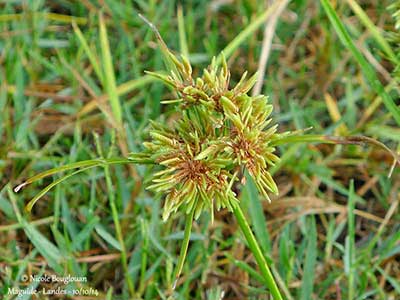
A male feeding alone utters a variety of calls described as “chint-chint”, “chwit”, “chweeo”, “choo” and “peep”, whereas the female gives the “chwit” call interspersed with longer “wit-wit-wit” series.
These calls are probably used to maintain contact between mates while foraging among the vegetation. They are monogamous.
During the breeding season, the Large-billed Seed-Finch male is territorial and defends its area by singing. Defence behaviour between two rivals involves chasing and supplanting. The bird sings from high song posts.
The male also performs a song flight display consisting of high flight over its territory while uttering songs with terminal trills and warbles, different from the usual song given from perch. It may perform sexual chase after the female. During the flight displays, the white wing patch of the primaries is enhanced by the wingbeats.
The Large-billed Seed-Finch is resident in its range. Its flight is direct.
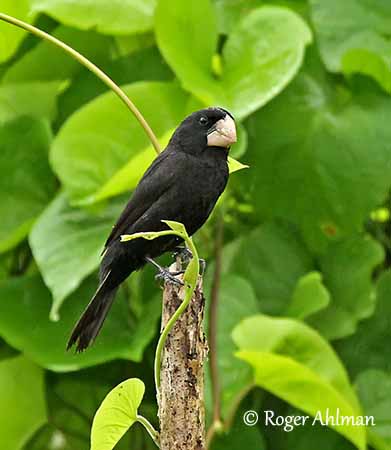
REPRODUCTION OF THIS SPECIES:
The Large-billed Seed-Finch breeds between March and September, depending on the range.
The nest is usually placed low in bush or shrub. It is a loose cup-shaped structure made with stems and grass, with a lining of softer material. The rim of the cup is usually covered with green moss.
The female lays 2-3 greyish-brown eggs with darker markings. The female incubates alone during 12-13 days, because the male lacks the incubating patch. It may sometimes bring some insects to the female at nest, but usually, it rarely visits the nest during this period.
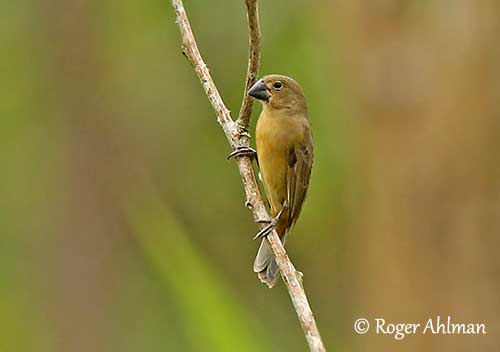
After hatching, the chicks are fed by both parents. Later, once fledged, 10 days after hatching, they are fed only by the male while the female starts a second clutch. They are independent 3-4 weeks later.
PROTECTION / THREATS / STATUS:
The Large-billed Seed-Finch is suspected to be in decline, due to trapping pressure for cagebird trade. But this species is naturally localized and scarce in most of the range. It is also threatened by habitat loss through deforestation.
The population is decreasing, but currently, the Large-billed Seed-Finch is still evaluated as Least Concern.
